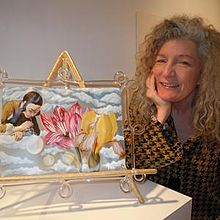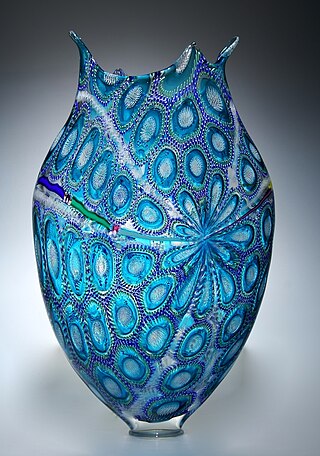
Studio glass is the modern use of glass as an artistic medium to produce sculptures or three-dimensional artworks in the fine arts. The glass objects created are intended to make a sculptural or decorative statement, and typically serve no useful function. Though usage varies, the term is properly restricted to glass made as art in small workshops, typically with the personal involvement of the artist who designed the piece. This is in contrast to art glass, made by craftsmen in factories, and glass art, covering the whole range of glass with artistic interest made throughout history. Both art glass and studio glass originate in the 19th century, and the terms compare with studio pottery and art pottery, but in glass the term "studio glass" is mostly used for work made in the period beginning in the 1960s with a major revival in interest in artistic glassmaking.

The Smithsonian American Art Museum is a museum in Washington, D.C., part of the Smithsonian Institution. Together with its branch museum, the Renwick Gallery, SAAM holds one of the world's largest and most inclusive collections of art, from the colonial period to the present, made in the United States. More than 7,000 artists are represented in the museum's collection. Most exhibitions are held in the museum's main building, the Old Patent Office Building, while craft-focused exhibitions are shown in the Renwick Gallery.

Lampworking is a type of glasswork in which a torch or lamp is used to melt the glass. Once in a molten state, the glass is formed by blowing and shaping with tools and hand movements. It is also known as flameworking or torchworking, as the modern practice no longer uses oil-fueled lamps. Although lack of a precise definition for lampworking makes it difficult to determine when this technique was first developed, the earliest verifiable lampworked glass is probably a collection of beads thought to date to the fifth century BCE. Lampworking became widely practiced in Murano, Italy in the 14th century. As early as the 17th century, itinerant glassworkers demonstrated lampworking to the public. In the mid-19th century lampwork technique was extended to the production of paperweights, primarily in France, where it became a popular art form, still collected today. Lampworking differs from glassblowing in that glassblowing uses a furnace as the primary heat source, although torches are also used.

The Renwick Gallery is a branch of the Smithsonian American Art Museum located in Washington, D.C. that displays American craft and decorative arts from the 19th to 21st century. The gallery is housed in a National Historic Landmark building that was opened in 1859 on Pennsylvania Avenue and originally housed the Corcoran Gallery of Art. When it was built in 1859, it was called "the American Louvre", and is now named for its architect James Renwick Jr.
Judy Jensen is an American artist who resides in Austin, Texas. She is best known for her reverse painting on glass, although she incorporates other mixed media into her glass pieces. According to Nancy Bless, Jensen's works "lie somewhere between a collage and a collection."

Hans Godo Frabel is an East German–born lampwork glass blower, now living and working in the US.

The Corning Museum of Glass is a museum in Corning, New York in the United States, dedicated to the art, history, and science of glass. It was founded in 1951 by Corning Glass Works and currently has a collection of more than 50,000 glass objects, some over 3,500 years old.
Judith Schaechter is a Philadelphia-based artist known for her work in the medium of stained glass. Her pieces often use symbolism from stained glass and Gothic traditions, but the distorted faces and figures in her work recall a 20th century German Expressionist painting style and her subject matter is secular. Shaechter's work often involves images that might be considered disturbing such as death, disease, or violence. Early Schaechter pieces, for example, such as King of Maggots and Vide Futentes make use of memento mori, symbols of death found in church architecture during medieval times.
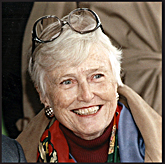
Doris Totten Chase was an American painter, teacher, and sculptor. She was a member of the Northwest School. Chase had a substantial career as a painter and sculptor before she set off for New York, where she made video art.
Preston Singletary is a Native American glass artist.

Karen LaMonte is an American artist known for her life-size sculptures in ceramic, bronze, marble, and cast glass.
Sonja Blomdahl is an American blown glass artist.

Joyce J. Scott is an African-American artist, sculptor, quilter, performance artist, installation artist, print-maker, lecturer and educator. Named a MacArthur Fellow in 2016, and a Smithsonian Visionary Artist in 2019, Scott is best known for her figurative sculptures and jewelry using free form, off-loom beadweaving techniques, similar to a peyote stitch. Each piece is often constructed using thousands of glass seed beads or pony beads, and sometimes other found objects or materials such as glass, quilting and leather. In 2018, she was hailed for working in new medium — a mixture of soil, clay, straw, and cement — for a sculpture meant to disintegrate and return to the earth. Scott is influenced by a variety of diverse cultures, including Native American and African traditions, Mexican, Czech, and Russian beadwork, illustration and comic books, and pop culture.
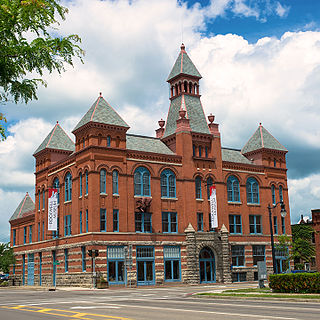
The Rockwell Museum is a Smithsonian Affiliate museum of American art located in the Southern Tier region of New York in downtown Corning, New York. Frommer's describes it as "one of the best-designed small museums in the Northeast." In 2015, The Rockwell Museum was named a Smithsonian Affiliate, the first in New York State outside of New York City.
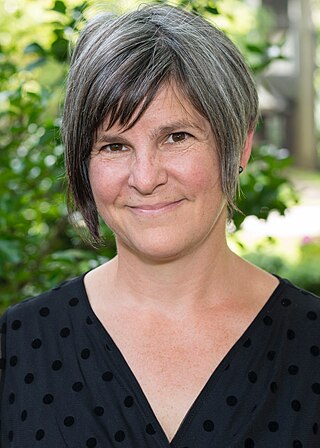
Beth Lipman is a contemporary artist working in glass. She is best known for her glass still-life compositions which reference the work of 16th- and 17th-century European painters.
Debora Moore is a contemporary glass artist. She is best known for her glass orchids.

Mary Ann Zynsky, better known as Toots Zynsky, is an American glass artist.
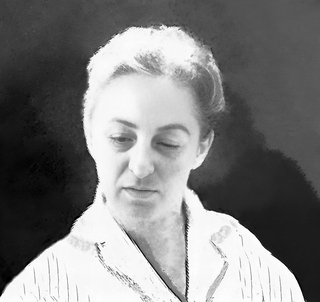
Věra Lišková was a Czech glass artist. She is known for pioneering the use of borosilicate glass or pyrex in glass art.

Urban Garden is a sculpture by Ginny Ruffner, installed in Seattle, Washington, United States. It depicts a pot, flowers, and watering can. The 27-foot-tall kinetic sculpture was commissioned by the Sheraton Seattle Hotel and weighs approximately 10,000 pounds. The pot is 9 feet tall and 7 feet wide.
Kit Paulson is an American artist known for glass flamework. She attended Alfred University and Southern Illinois University Carbondale. Paulson completed residencies at Salem State University in Salem, Massachusetts, the Museum of Glass in Tacoma, Washington, and the Penland School of Craft. She has taught at Penland as well as Bild-Werk Frauenau in Bavaria, Germany. Her work, Lungs, was acquired by the Smithsonian American Art Museum as part of the Renwick Gallery's 50th Anniversary Campaign.
